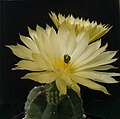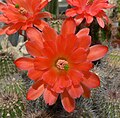| Section | Image | Scientific name | Subspecies | Distribution |
|---|
| Costati (Engelm.) N.P.Taylor (1994) |  | Echinocereus berlandieri (Engelm.) Haage | | Mexico, Texas |
|---|
 | Echinocereus cinerascens (DC.) Lem. | - Echinocereus cinerascens subsp. cinerascens
- Echinocereus cinerascens subsp. septentrionalis(N.P.Taylor) N.P.Taylor
- Echinocereus cinerascens subsp. tulensis(Bravo) N.P.Taylor
| Texas to Mexico |
 | Echinocereus enneacanthus Engelm. | | Mexico (Jalisco) |
 | Echinocereus freudenbergeri G.Frank | | Mexico (S. Coahuila) |
 | Echinocereus longisetus (Engelm.) Lem. | - Echinocereus longisetus subsp. delaetii(Gürke) N.P.Taylor
- Echinocereus longisetus subsp. longisetus
| Mexico (Coahuila). |
 | Echinocereus nivosus Glass & R.A.Foster | | Mexico (SE. Coahuila, Nuevo León) |
 | Echinocereus papillosus Linke ex Rümpler | | Texas to NE. Mexico |
 | Echinocereus parkeri N.P.Taylor | - Echinocereus parkeri subsp. arteagensisW.Blum & Mich.Lange
- Echinocereus parkeri subsp. gonzalezii(N.P.Taylor) N.P.Taylor
- Echinocereus parkeri subsp. mazapilensisW.Blum & Mich.Lange
- Echinocereus parkeri subsp. parkeri
| Mexico. |
 | Echinocereus rayonesensis N.P.Taylor | | Mexico (Coahuila, Nuevo León, Tamaulipas). |
 | Echinocereus stramineus (Engelm.) F.Seitz | | New Mexico to W. Texas and NE. Mexico |
 | Echinocereus viereckii Werderm. | - Echinocereus viereckii subsp. morricalii(Říha) N.P.Taylor
- Echinocereus viereckii subsp. viereckii
| Mexico (SW. Tamaulipas, Nuevo León, Coahuila). |
 | Echinocereus zapalinamensis W.Blum & J.Flores Ventura | | Mexico (Coahuila) |
| Echinocereus | | Echinocereus blumii D.Felix & H.Bauer | | Mexico (Coahuila) |
|---|
 | Echinocereus canus D.Felix & H.Bauer | | Texas |
 | Echinocereus chloranthus (Engelm.) Haage | | SE. Arizona to W. Texas and Mexico (Chihuahua) |
 | Echinocereus davisii Houghton | | Texas |
 | Echinocereus mapimiensis E.F.Anderson, W.C.Hodgs. & P.Quirk | | Mexico (Coahuila, Durango) |
 | Echinocereus milleri W.Blum, Kuenzler & Oldach | | Texas |
 | Echinocereus neocapillus (Weniger) W.Blum & Mich.Lange | | W. Texas |
 | Echinocereus pentalophus (DC.) J.N.Haage | - Echinocereus pentalophus subsp. leonensis(Mathsson) N.P.Taylor
- Echinocereus pentalophus subsp. pentalophus
- Echinocereus pentalophus subsp. procumbens(Engelm.) W.Blum & Mich.Lange
| Texas, Mexico (to Jalisco) |
 | Echinocereus occidentalis (N.P.Taylor) W.Rischer, S.Breckw. & Breckw. | - Echinocereus occidentalis subsp. breckwoldtiorumDe-Nova, Cast.-Lara & W.Blum
- Echinocereus occidentalis subsp. occidentalis
| Mexico |
 | Echinocereus russanthus D.Weniger | | Texas to Mexico (Chihuahua, Coahuila) |
 | Echinocereus viridiflorus Engelm. | - Echinocereus viridiflorus subsp. correllii(L.D.Benson) W.Blum & Mich.Lange
- Echinocereus viridiflorus subsp. viridiflorus
| SW. South Dakota to N. Texas and Mexico (Coahuila) |
| Erecti (K.Schum.) Bravo (1982) |  | Echinocereus apachensis W.Blum & Rutow | | Arizona. |
|---|
 | Echinocereus barthelowianus Britton & Rose | | Mexico (Island Magdalena) |
 | Echinocereus bonkerae Thornber & Bonker | | Arizona |
 | Echinocereus brandegeei (J.M.Coult.) K.Schum. | | Mexico (Baja California) |
 | Echinocereus dasyacanthus Engelm. | - Echinocereus dasyacanthus subsp. ctenoides(Engelm.) Lodé
- Echinocereus dasyacanthus subsp. dasyacanthus
- Echinocereus dasyacanthus subsp. multispinosusD.Felix & H.Bauer
- Echinocereus dasyacanthus subsp. rectispinus(Trocha & Fethke) W.Blum, W.Rischer & Rutow
| Mexico (Coahuila) |
 | Echinocereus engelmannii (Parry ex Engelm.) Lem. | - Echinocereus engelmannii subsp. engelmannii
- Echinocereus engelmannii subsp. llanuraensis(Rutow) Felger
| United States (Arizona, Colorado, New Mexico, Texas, Utah), Mexico |
 | Echinocereus fasciculatus (Engelm. ex B.D.Jacks.) L.D.Benson | | Colorado to NE. Mexico. |
 | Echinocereus felixianus H.Bauer | | New Mexico, Texas, Mexico (N. Sonora to N. Chihuahua) |
 | Echinocereus fendleri (Engelm.) Sencke ex J.N.Haage | - Echinocereus fendleri subsp. fendleri
- Echinocereus fendleri subsp. rectispinus(Peebles) N.P.Taylor
| Arizona, California, Nevada, Utah; Mexico (Baja California, NW. Sonora). |
 | Echinocereus ferreirianus H.E.Gates | - Echinocereus ferreirianus subsp. ferreirianus
- Echinocereus ferreirianus subsp. lindsayorum(J.Meyrán) N.P.Taylor
| Mexico (C. Baja California) |
 | Echinocereus ledingii Peebles | | Arizona. |
 | Echinocereus maritimus (M.E.Jones) K.Schum. | | Mexico (Baja California). |
 | Echinocereus nicholii (L.D.Benson) B.D.Parfitt | | Arizona to Mexico (Sonora) |
 | Echinocereus pectinatus (Scheidw.) Engelm. | - Echinocereus pectinatus subsp. pectinatus
- Echinocereus pectinatus subsp. rutowiorumW.Blum
- Echinocereus pectinatus subsp. wenigeri(L.D.Benson) W.Blum & Rutow
| Mexico. |
 | Echinocereus perplexus W.Blum & A.P.Campos | | Texas |
 | Echinocereus relictus Wellard | | Utah |
| Pulchellus N.P.Taylor (1985) | | Echinocereus acanthosetus (S.Arias & U.Guzmán) Gómez-Quintero & Dan.Sánchez | | Mexico |
|---|
 | Echinocereus adustus Engelm. | - Echinocereus adustus subsp. adustus
- Echinocereus adustus subsp. roemerianusW.Rischer
- Echinocereus adustus subsp. schwarzii(A.B.Lau) N.P.Taylor
| Mexico (Chihuahua) |
 | Echinocereus knippelianus Liebner | | Mexico (SE. Coahuila, Nuevo León, Tamaulipas, San Luis Potosí). |
 | Echinocereus laui G.Frank | | Mexico (E. Sonora, Chihuahua) |
 | Echinocereus pamanesii A.B.Lau | - Echinocereus pamanesii subsp. bonatzii(R.C.Römer) R.C.Römer
- Echinocereus pamanesii subsp. pamanesii
| Mexico (Zacatecas) |
 | Echinocereus pulchellus (Mart.) K.Schum. | | Mexico (Hidalgo, Puebla) |
 | Echinocereus schereri G.Frank | | Mexico (Durango). |
| Echinocereus sharpii (N.P.Taylor) Dan.Sánchez & Gómez-Quintero | | Mexico (Nuevo León) |
 | Echinocereus weinbergii Weing. | - Echinocereus weinbergii subsp. venustus(W.Blum & W.Rischer) Gómez-Quintero & Dan.Sánchez
- Echinocereus weinbergii subsp. weinbergii
| Mexico (Jalisco) |
| Reichenbachii N.P.Taylor (1985) |  | Echinocereus bristolii W.T.Marshall | | Mexico (Sonora) |
|---|
 | Echinocereus chisosensis W.T.Marshall | - Echinocereus chisosensis subsp. chisosensis
- Echinocereus chisosensis subsp. fobeanus(Oehme) N.P.Taylor
| Texas to Mexico |
| Echinocereus grandis Britton & Rose | | Mexico (Islands de las Animas) |
 | Echinocereus palmeri Britton & Rose | - Echinocereus palmeri subsp. mazapilH.M.Hern. & Gómez-Hin.
- Echinocereus palmeri subsp. palmeri
| Mexico (Chihuahua, Durango) |
 | Echinocereus primolanatus Fritz Schwarz ex N.P.Taylor | | Mexico (to Jalisco). |
| Echinocereus pseudopectinatus (N.P.Taylor) N.P.Taylor | | Arizona to Mexico (NE. Sonora) |
 | Echinocereus reichenbachii (Terscheck ex Walp.) J.N.Haage | - Echinocereus reichenbachii subsp. armatus(Poselger) N.P.Taylor
- Echinocereus reichenbachii subsp. baileyi(Rose) N.P.Taylor
- Echinocereus reichenbachii subsp. burrensisG.Frank, Metorn & E.Scherer
- Echinocereus reichenbachii subsp. fitchii(Britton & Rose) N.P.Taylor
- Echinocereus reichenbachii subsp. perbellus(Britton & Rose) N.P.Taylor
- Echinocereus reichenbachii subsp. reichenbachii
| Colorado, Kansas, New Mexico, Oklahoma, Texas; Mexico |
 | Echinocereus rigidissimus (Engelm.) Rose | - Echinocereus rigidissimus subsp. rigidissimus
- Echinocereus rigidissimus subsp. rubispinus(G.Frank & A.B.Lau) N.P.Taylor
| New Mexico, Arizona and N. Mexico |
 | Echinocereus sciurus (K.Brandegee) Dams | - Echinocereus sciurus subsp. floresii(Schwarz ex Backeb.) N.P.Taylor
- Echinocereus sciurus subsp. sciurus
| Mexico (S. Baja California Sur) |
 | Echinocereus scopulorum Britton & Rose | | Mexico (to Nayarit) |
 | Echinocereus spinigemmatus A.B.Lau | | Mexico (NW. Jalisco, W. Zacatecas) |
 | Echinocereus stolonifer W.T.Marshall | - Echinocereus stolonifer subsp. stolonifer
- Echinocereus stolonifer subsp. tayopensis(W.T.Marshall) N.P.Taylor
| Mexico (SE. Sonora, Sinaloa) |
 | Echinocereus subinermis Salm-Dyck ex Scheer | - Echinocereus subinermis subsp. ochoterenae(J.G.Ortega) N.P.Taylor
- Echinocereus subinermis subsp. subinermis
| Mexico (Sonora, Sinaloa, SW. Chihuahua, Durango) |
 | Echinocereus websterianus G.E.Linds. | | Mexico (Sonora: Island San Pedro Nolasco) |
| Triglochidiata Bravo 1973 |  | Echinocereus acifer (Otto ex Salm-Dyck) Jacobi | | Mexico |
|---|
 | Echinocereus arizonicus Rose ex Orcutt | - Echinocereus arizonicus subsp. arizonicus
- Echinocereus arizonicus subsp. matudae(Bravo) Rutow
- Echinocereus arizonicus subsp. nigrihorridispinusW.Blum & Rutow
| Arizona, New Mexico, Mexico |
 | Echinocereus bakeri W.Blum, Oldach & J.Oldach | | Arizona, Nevada, Utah |
 | Echinocereus coccineus Engelm. | - Echinocereus coccineus subsp. coccineus
- Echinocereus coccineus subsp. paucispinus(Engelm.) W.Blum, Mich.Lange & Rutow
- Echinocereus coccineus subsp. rosei(Wooton & Standl.) W.Blum & Rutow
| New Mexico and Mexico (Sonora, Sinaloa, Chihuahua) |
 | Echinocereus gurneyi (L.D.Benson) W.Blum, Oldach & J.Oldach | | Texas. |
 | Echinocereus huitcholensis (F.A.C.Weber) M.Gürke | | Mexico (SE. Sinaloa to NW. Jalisco) |
 | Echinocereus marksianus Fritz Schwarz ex Backeb. | | Mexico (San Luis Potosí) |
 | Echinocereus ortegae Rose | - Echinocereus ortegae subsp. koehresianus(G.Frank) W.Rischer & G.Frank
- Echinocereus ortegae subsp. ortegae
| Mexico |
 | Echinocereus pacificus (Engelm.) Britton & Rose | - Echinocereus pacificus subsp. mombergerianus(G.Frank) W.Blum, W.Rischer & Rutow
- Echinocereus pacificus subsp. pacificus
| Mexico (Baja California) |
 | Echinocereus polyacanthus Engelm. | | Mexico (Chihuahua to Jalisco). |
 | Echinocereus salm-dyckianus Scheer | | Mexico (E. Sonora to W. Chihuahua) |
 | Echinocereus santaritensis W.Blum & Rutow | - Echinocereus santaritensis subsp. bacanorensis(W.Rischer & Trocha) W.Rischer & D.Felix
- Echinocereus santaritensis subsp. santaritensis
| Arizona to New Mexico and Mexico (Sonora, Chihuahua) |
 | Echinocereus scheeri (Salm-Dyck) Scheer | - Echinocereus scheeri subsp. gentryi(Clover) N.P.Taylor
- Echinocereus scheeri subsp. scheeri
| Mexico (E. Sonora to W. Durango) |
 | Echinocereus triglochidiatus Engelm. | - Echinocereus triglochidiatus subsp. mojavensis(Engelm. & J.M.Bigelow) W.Blum & Mich.Lange
- Echinocereus triglochidiatus subsp. triglochidiatus
| Colorado to New Mexico and NW. Mexico. |
 | Echinocereus yavapaiensis M.A.Baker | | Arizona |
| Wilcoxia (Britton & Rose) N.P.Taylor (1985) | | Echinocereus kroenleinii (Mich.Lange) W.Blum & Waldeis | | Mexico (Coahuila) |
|---|
 | Echinocereus leucanthus N.P.Taylor | | Mexico (NW. Sonora, NW. Sinaloa) |
 | Echinocereus poselgeri Lem. | | Texas to NE. Mexico. |
 | Echinocereus schmollii (Weing.) N.P.Taylor | | Mexico (SE. Querétaro to Hidalgo) |
 | Echinocereus waldeisii Haugg | | Mexico (San Luis Potosí) |
|














































































